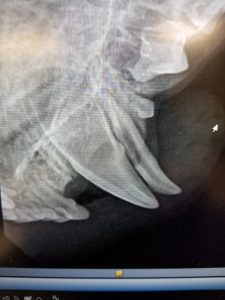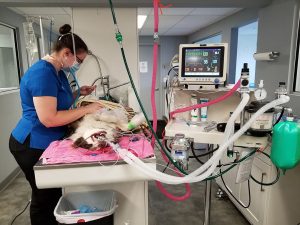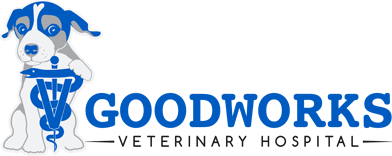Do you know the most common disease in dogs and cats?
 Dental disease is the most common disease in dogs and cats, and by age three most dogs and cats have some form of dental disease. Goodworks is dedicated to providing your pet complete, modern dental care. During a wellness exam, the doctor will evaluate your pet’s dental health. If signs of dental disease are found, the doctor may recommend a full dental evaluation under anesthesia. A written treatment plan and estimate will be provided to you. You will need to provide a phone number where you can be reached during the procedure.
Dental disease is the most common disease in dogs and cats, and by age three most dogs and cats have some form of dental disease. Goodworks is dedicated to providing your pet complete, modern dental care. During a wellness exam, the doctor will evaluate your pet’s dental health. If signs of dental disease are found, the doctor may recommend a full dental evaluation under anesthesia. A written treatment plan and estimate will be provided to you. You will need to provide a phone number where you can be reached during the procedure.
During a full dental exam, the veterinary technician will begin by taking dental radiographs of all the teeth. The veterinarian will interpret the radiographs while the technician uses a combination of hand instruments and an ultrasonic scaler to clean above and below the gumline. After scaling, a polisher is used to smooth the enamel. In addition to interpreting the radiographs, the veterinarian will examine the pet’s mouth for loose or fractured teeth, abscesses, oral masses, and other abnormalities. The veterinarian will call you during the procedure if there are any unexpected findings. It is quite common to find disease on the dental radiographs that is not apparent during a routine physical exam.
 As dental procedures require your pet to be placed under anesthesia, we give them the same care as every surgery patient. Goodworks offers in-house pre-anesthetic blood screening for the utmost in safety and this blood screening is required for all patients undergoing anesthesia for a dental exam and cleaning. Check out our Lab Services to see how we can help your pet! This blood screening ensures that your pet is healthy enough to receive anesthetics by checking parameters related to kidney and liver function. It also checks values related to blood cells. The anesthetics administered are specifically tailored to your pet and depend upon your pet’s health status and procedure(s) to be performed.
As dental procedures require your pet to be placed under anesthesia, we give them the same care as every surgery patient. Goodworks offers in-house pre-anesthetic blood screening for the utmost in safety and this blood screening is required for all patients undergoing anesthesia for a dental exam and cleaning. Check out our Lab Services to see how we can help your pet! This blood screening ensures that your pet is healthy enough to receive anesthetics by checking parameters related to kidney and liver function. It also checks values related to blood cells. The anesthetics administered are specifically tailored to your pet and depend upon your pet’s health status and procedure(s) to be performed.
We have state of the art equipment for monitoring your pet during surgery. We monitor your pet’s heart (rate & rhythm), oxygen saturation, carbon dioxide, respiration, temperature, and blood pressure. More important than the equipment, however, is active monitoring by trained personnel. Goodworks employs highly skilled registered veterinary technicians that will ensure all surgical patients are closely monitored and given intensive care through anesthesia and the recovery phase. Furthermore, intravenous (IV) fluid therapy is standard for all patients during surgery. Providing IV fluids while under anesthesia allows us to intervene quickly and immediately if a pet has any anesthetic abnormalities such as a dangerous drop in blood pressure or heart rate.  The fluid rate can be adjusted as necessary and emergency drugs can be administered without having to place an IV catheter in an emergency situation. In addition to fluid therapy, each patient will be placed on a circulating warm water mat during surgery to help maintain core body temperature. This improves circulation and aids in the speed of recovery from anesthesia. We strive to remain at the forefront of the veterinary medical field and to provide your pet with the highest quality medical care.
The fluid rate can be adjusted as necessary and emergency drugs can be administered without having to place an IV catheter in an emergency situation. In addition to fluid therapy, each patient will be placed on a circulating warm water mat during surgery to help maintain core body temperature. This improves circulation and aids in the speed of recovery from anesthesia. We strive to remain at the forefront of the veterinary medical field and to provide your pet with the highest quality medical care.
